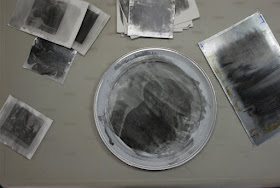However, I finally stumbled upon the winning combination of using unreactive materials (such as paper and aluminum) that had rough or roughened surfaces and produced some successful results. The trick was that some materials such as metal, which have smooth surfaces, had to first be roughened either by sanding or primer in order to make the Liquid Light emulsion stick throughout the development process.
A few tips:
1. Liquid Light is sensitive to yellow and amber safety lights over short periods of time, but if you work in a very dark room, such as one used for loading film, you can crack the door open slightly to get a tiny, tiny bit of ambient light to work with. It won't expose the Liquid Light, and it's much easier to coat your objects with light than in the dark.
2. Let the Liquid Light dry before exposing it. If you try and expose a wet Liquid Light photograph, then it will more often than not be massively overexposed.
3. When developing the exposed Liquid Light object, don't agitate the object too much in the developing chemicals, because the emulsion has a tendency to become wet again if it's on nonporous objects (like metal) and it may fall off the surface if it hasn't been properly prepared.
Below are some examples:
The metal sheet to the right is the one that reacted with the fixer to produce sulfur. I believe it was made of galvanized tin or steel.
I had great success with using recycled mat card pieces, as shown on the left side.
Unreactive metal such as stainless steel and aluminum also works.
The dish in the center is aluminum with a white primer coating on it.

Thanks for all the tips Kevin. Your list will be very helpful the next time we have students using Liquid Light.
ReplyDelete